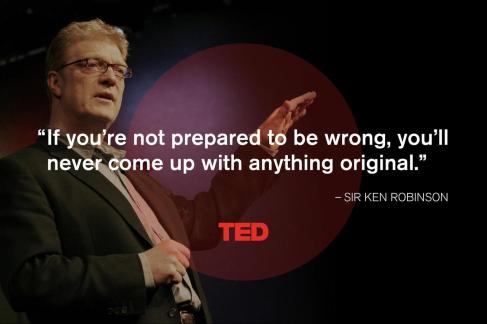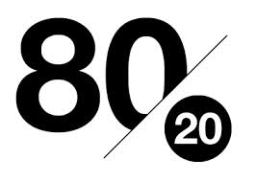Imagine letting students do whatever they want in your classroom. Imagine the chaos, the pandemonium, the accidents waiting to happen. Can you imagine anything more irresponsible?
Well, that is precisely what I’m doing this year with my Accelerated Freshman English students. I’m giving them complete ownership of 20% of their class time.*
What’s my deal? Stupidity? Masochism? A penchant for being fired?
I will attempt to explain.
It’s difficult to take in a day’s news without running across a story of our failing educational system, without hearing how public education is draining every ounce of creativity, individuality, autonomy from its students. Sir Ken Robinson is perhaps the most salient voice in this camp as evidenced by the 19 million hits on his Do Schools Kill Creativity TED Talk.

Robinson asserts that creativity is as important as reading, writing and arithmetic. He contends that students must follow their passions. They must try and fail, and learn from that failure: “If you’re not prepared to be wrong, you’ll never be able to come up with something original.” He says that our educational system succeeds at producing two extremes: point mongers and drop outs while it fails produce self-motivated, creative thinkers passionate about their learning.
I agree with Robinson’s assessment, and as an educator, I must bear some complicity.
Enter, “Genius Hour” based on Google and 3M’s 20% time. These mammoth conglomerates maintain policies seem counter-productive at face value. They require their workers to spend 80% of their time on company projects, but then allow them to spend 20% of their time (1 day per week) exploring leads, ideas, curiosities. Time to be creative.
This policy has proved worthy as Google’s Gmail, the #1 email provider in the world, is the result of 20% time as is the invention of 3M’s Post-it note (without which I personally would be at least 20% less efficient). It seems that time to play, time to be creative, time to dabble pays off both in innovation and profit.
So when I read about Kevin Brookhauser’s experience with 20% time in his classroom, I knew this was something I had to try. It was not a capricious decision on my part. Class time is golden. With the increasing demands on test scores and Common Core implementation, it seems there’s less time than ever for implementing innovative ideas in the classroom.
However, since educational relevance (or lack thereof) is something that keeps me up at night (as regular readers of my blog will testify), I felt not only justified but obliged to try 20% in my classroom this year.
I started with a fairly lengthy parent letter, explaining the what and why of this unconventional undertaking. I shared it with my principal, who was excited: “I expect we’ll get a lot of calls about this (dramatic pause to convey perceived anxiety) This is the kind of thing we need to be doing.”
Parents notified, it was now time to hook the kids. I showed them Ken Robinson’s “Do Schools Kill Creativity?” and asked them to blog their reactions. Here are a few representative quote:
- “If you are unprepared to be wrong, you will never be able to think of original ideas, and even if you do, you won’t have the confidence to share your ideas with others.”
- “Creativity allows the chains on the mind to be released for a while. The real issue here is that parents and teachers have to decide what is more important; a child’s happiness, or molding their children into what THEY want for their future.”
- “School teaches us to focus on memorizing facts and that coming up with anything original is unimportant to our future. This is a terrible problem because the world needs creativity for that new invention that saves our earth, for that new book that starts a revolution, for that one vaccine that everyone needs. Yes, science and math is important for this as well, but creativity is also key.”
- “If schools want to have brilliant students that can change the world, they should make creativity just as important as social studies, science, math, and all the other ‘intelligent’ subjects.”
Clearly, my students were all singing the same song with Sir Ken Robinson as their conductor. Some were a bit skeptical about how to change the  system, but not one questioned if it should be changed. Student 20% “buy in” was mounting.
system, but not one questioned if it should be changed. Student 20% “buy in” was mounting.
 system, but not one questioned if it should be changed. Student 20% “buy in” was mounting.
system, but not one questioned if it should be changed. Student 20% “buy in” was mounting.
Next, I had them “Google” 20% project and react to their findings on a shared electronic bulletin board: I read their reactions aloud as they typed.
One wrote, “I wish w e could do this at school.” “You know what?” I responded aloud, “We are!” It was at that moment that Travis (a student I had been warned about, a student who was reluctantly placed in Accelerated Freshman English) fell out of his chair in disbelief.
“Really? he asked, brushing his hair out of his eyes, “Seriously?”
“Really,” I said. 10 years of public education had left him incredulous.
“I can decide what I want to learn 1 day a week?” he asked from the floor.
“Yes!”
I was feeling pretty good about this. So were they. I was a bit surprised then upon receiving a heated email from a parent who “disapproves” of the project, asserting that her daughter can be “creative” and have “fun” outside of school when all of her work is done. She was concerned that this project would be “wasting” 20% of her daughter’s time and would not prepare her for the competitive world she will face upon graduation.
I wrote her back with assurance that the other 80% of the week would be spent in intensive language arts study: reading, analyzing, writing. I also explained that while the 20% day would likely be “fun” and “creative” it would also involve higher order thinking and would require students to authentically apply language arts skills: speaking, researching, writing while following their interests and leveraging their creativity and passion for meaningful learning. I assured her that her daughter would be mentored through the process (by me and by a community member) and would be required to generate a product and reflect on her learning at the conclusion of the project.
Her response: “I figured that relaying (my) opinion would not change this project. So we are perfectly clear, we still disagree with this project.” Interestingly, I while I was fully prepared to offer her daughter alternative use of the 20% time, I quickly discovered that she was (and is) through-the-roof excited about her 20% time.
I received only one other email from a parent. This one from the mother of Travis (fall-out-of-his-desk-in-disbelief Travis): “Sounds like an incredible experience. Thanks for your outside-the-box teaching! Can’t wait to see what comes of this!”
And so, we’ve started 20% time, and here are some of their projects:
- Two word lovers are creating their own language (researching the grammatical and syntactical components of a language and then creating one anew).
- Two athletes are creating a low-cost, highly effective sports drink (research, trial, error, and publishing the results).
- An equestrienne is creating a website which houses a series of show patterns (video, voice, and diagram) to help other riders train and show their horses.
- One student is examining her dream career: Pediatric Nursing: reading and researching and archiving everything she can find on it.
- Three students are researching lucid dreaming and creating a documentary on what it is, its usefulness, and the controversies surrounding it.
- A student who is a childhood cancer survivor is making and distributing hope bracelets for children with cancer.
- A pianist is recording and publicizing her songs online.
- Two students interested in 3D modeling are creating a model for a high-tech interactive residential house.
- A superhero fan is writing and illustrating an original comic book in which Marvel superheroes battle DC comic superheroes.
- A fishing fanatic is testing, creating and blogging the “how to’s” for making your own low-cost fishing lures.
- An aspiring artist is trying out a new artistic genre each week, taking pictures of each step and sharing it on a website.
- Two students are doing heavy duty ferret research, creating an online insider’s owners manual for ferrets.
- Two students are writing a multimedia ABC book about Female Basketball players.
- One student is making tennis racket dampeners (new to me) out of various household materials and sharing the “how to” instructions online.
- Two students have started a Club at school (Club 365) focused on celebrating every day and interacting with those around them (Shake a Stranger’s Hand Day, Random Act of Kindness Day, etc.)
So time will tell. We’ll see which parent was right: we’ll see if 20% time turns out to be “wasted time” or “an incredible experience.”
I’ll keep you posted.
* Note: How can you give someone something that’s already theirs? Isn’t time at school THEIR time? The question itself is comic and tragic. We consider students to be OURS when they’re in OUR classrooms. It’s OUR time. They are OUR captive audience. 20% is then an attempt to allow them to reclaim what is rightfully theirs.